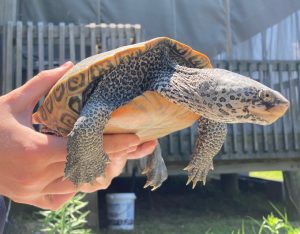2021 Terrapin Highlights
by Brian Williamson, Research Scientist

Adult female diamondback terrapin Y2K, recaptured and released after nesting for her fourth time this season. She was tagged as a head-starter in 2000.
This year also marks the 25th anniversary of our mark-recapture project, in which we tag terrapins using microchips with unique codes that allow us to identify them when we see them again. Four terrapins were captured this year that were first tagged in 1997, three of which were likely sexually mature and at least 6-8 years old when captured. This means that all of these turtles are at least 30 years old, and the oldest of them may be nearing 40 years old. All of them have been captured multiple times nesting on our property. Terrapins, and other turtles, can reproduce their entire lives, so we hope we will continue to see them each year seeking nest sites on our trail. Terrapins are believed to live 20-40 years in the wild, and we hope to learn more about their maximum lifespan as we continue our research in 2022 and beyond.
